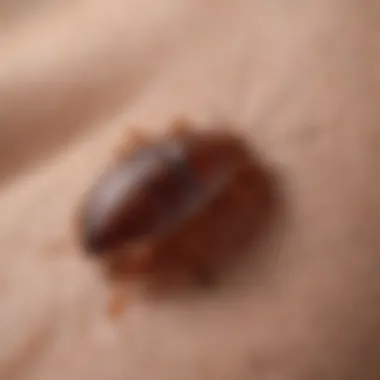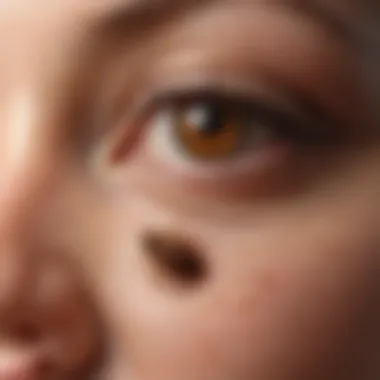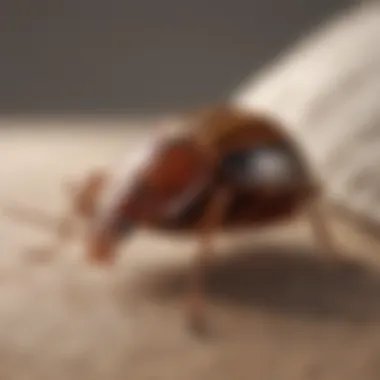Understanding the Symptoms of Bed Bug Bites


Intro
Bed bugs are small insects that thrive on blood from humans and animals. They are usually found in warm environments, often hiding in mattresses, bed frames, or furniture. Their presence can lead to discomfort and various health issues due to their bites. Understanding the symptoms often associated with bed bug bites is essential for timely intervention and treatment.
Understanding Pests
Definition of Pests
Insects like bed bugs are known as pests because they negatively impact living conditions. A pest creates problems by feeding on human bodies or consuming food that is meant for humans. They can become a significant nuisance, especially when they infest homes, creating both physical discomfort and emotional stress for residents.
Importance of Pest Identification
Identifying bed bugs quickly is crucial. Bed bug bites can resemble those of other insects, leading to potential misdiagnosis of symptoms. Typically, the bites appear as small red welts, often clustered together. Understanding these signs enhances the chance of effective treatment and pest control. Knowing the characteristics of bed bug bites can also help in distinguishing them from bites of mosquitoes, fleas, or other pests.
"Timely identification of bed bug bites can guide effective management strategies."
Common symptoms associated with bed bug bites include:
- Red, itchy welts: The most notable sign.
- Swelling around the bite area: This may vary in intensity.
- Burning sensation: Particularly when scratching the irritated skin.
- Allergic reactions: Some individuals may experience more severe symptoms such as rash or difficulty breathing.
It is important to monitor these symptoms closely, as they can escalate if left untreated.
Prevention Techniques
Home and Garden Preventative Measures
Preventing bed bugs from invading your space is a vital strategy. Consider the following steps to minimize risk:
- Regular cleaning: Vacuum frequently, especially in sleeping areas.
- Inspection of second-hand furniture: Thoroughly check for bugs before bringing items home.
- Sealing cracks and crevices: This can help block entry points.
Seasonal Prevention Tips
Bed bugs tend to be more active in warmer months. To further protect your home:
- Utilize encasements for mattresses and box springs.
- Maintain proper ventilation to discourage infestations.
Eco-Friendly Pest Control Solutions
Overview of Sustainable Practices
Eco-friendly pest control focuses on solutions that minimize harm to the environment while managing bed bug issues. Options include heat treatments and the strategic use of diatomaceous earth, which is safe for indoor use.
Natural Remedies and Their Effectiveness
Many homeowners seek natural remedies to combat pest issues. Some common methods include:
- Essential oils: Oils like tea tree or lavender may deter bed bugs.
- Homemade sprays: Combining water and vinegar can be a non-toxic approach.
While these remedies may help, they are often less effective than professional treatments and should be part of a broader pest management strategy. Understanding these symptoms and taking preventive measures can enhance household comfort and well-being.
Preamble to Bed Bugs
Understanding bed bugs is pivotal in addressing the issues they pose, particularly concerning their bites. These pests do not merely disrupt comfort; their presence can lead to significant psychological stress and discomfort. Informing oneself about bed bugs can facilitate better identification and response strategies. Knowledge about bed bugs enables householders to minimize infestations and manage symptoms effectively.
Bed bugs are small, nocturnal insects that feed on the blood of warm-blooded animals, including humans. Their bites are often mistaken for other insect bites, which complicates effective treatment. Consequently, an informed approach can lead to quicker identification of bites, reducing confusion and unnecessary worry
In the sections that follow, we will clarify what exactly bed bugs are, how they function, and their life cycle. This foundational information is crucial for understanding how these insects affect daily life and health. Recognizing their characteristics and behavior is the first step toward effective management and prevention.
Identifying Bed Bug Bites


Identifying bed bug bites is crucial for understanding what individuals are experiencing and implementing appropriate responses. Knowing the characteristics of these bites helps differentiate them from other insect bites or skin conditions. This knowledge benefits housewives and homeowners in pinpointing potential infestations early. Early detection can prevent further discomfort and more extensive pest problems.
Common Characteristics of Bites
Bed bug bites share several common characteristics that set them apart from other insect bites. Typically, these bites appear as small, raised, red welts on the skin. They may be itchy and uncomfortable, often presenting in clusters or lines. The pattern of bites can suggest a bed bug presence, as they tend to feed in a line along exposed areas of skin.
The bites themselves may not become noticeable until a few days after the initial feeding. Initial reactions can vary widely among individuals. For some, a bite may only cause mild itching, while others may experience much more severe reactions. These reactions depend on individual sensitivity to bed bug saliva, which contains substances that prevent blood clotting and can trigger allergic reactions.
Locations of Bites
The locations of bed bug bites are often indicative of their source. Common areas where bites occur include:
- Arms
- Legs
- Neck
- Face
Bites usually affect areas that are exposed while sleeping. Bed bugs are nocturnal and prefer warm, cozy environments, which makes beds an ideal feeding ground. Individuals may notice bites in a straight line or in clusters, paralleling the bed bug's feeding pattern. Observing the locations of bites can provide vital clues in confirming the presence of bed bugs in a home.
Understanding the characteristics and common locations of bed bug bites is essential for prompt identification and management of infestations.
Recognizing these symptoms early can enhance the effectiveness of treatment options and pest control strategies.
Initial Reactions
Upon being bitten by a bed bug, the initial reactions can vary among individuals. Typically, the body responds to the bed bug's saliva, which contains anticoagulants, by initiating a localized inflammatory response. Some individuals may notice a slight tingling or burning sensation at the site of the bite soon after it occurs. This can be followed by a subtle redness or swelling.
Sensitivity to bites depends on various factors, including previous exposure. Those with no prior encounters with bed bugs might experience more pronounced initial reactions. Many report that the bites are often mistaken for mosquito bites, thus delaying recognition of a bed bug problem.
Presents of Red Welts
Red welts are one of the most common physical symptoms associated with bed bug bites. These welts can appear within hours of the bite or may take a few days to develop. They are typically small, raised, and reddish in color, often resembling a small pimple or hives. The welts may occur in clusters or lines, as bed bugs tend to bite multiple times in a single feeding session.
The presence of red welts signifies an allergic response to the chemicals in the bites. While they may be irritating and itchy, their appearance can serve as an indicator for victims to assess and investigate potential bed bug infestations in their living environment.
Blister Formation
In some cases, bed bug bites can lead to blister formation. This occurs primarily in individuals with heightened sensitivity. The blisters may be filled with clear fluid and can be quite uncomfortable. These are not typical for everyone, but when they do appear, they can complicate the healing process.
If blisters arise, it’s crucial not to pop them, as this could lead to secondary infections. Keeping the area clean and avoiding scratching is advisable. Treatment options include topical remedies that soothe itching and inflammation. Blistering can be a sign that the bites are severe enough to warrant further medical evaluation for those experiencing extensive reactions.
"Identification of symptoms early can mitigate discomfort and help prevent further complications from bed bug bites."
Understanding these symptoms is not just about alleviating discomfort but also about taking action in managing an infestation. By recognizing the physical manifestations of bed bug bites, individuals can take necessary preventive measures, remedy their environment, and seek appropriate treatments.
Variability in Reactions
Understanding the variability in reactions to bed bug bites is crucial for several reasons. Different individuals respond uniquely to these bites, influenced by factors such as their immune system and previous exposure to allergens. Recognizing this variability can aid in better identification and treatment of symptoms.
Each person's immune response varies significantly, leading to different types of reactions. Some individuals may experience minimal discomfort, while others may suffer severe itching or extensive swelling. This sensitivity emphasizes the need for awareness about personal health conditions, which can influence how one reacts to bed bug bites.
Individual Sensitivity Differences
Individual sensitivity to bed bug bites is a major element affecting the manifestation of symptoms. When an insect bites, it injects saliva containing anticoagulants that enable blood to flow freely. The body reacts to these proteins differently, leading to varied allergic responses. People who have never been bitten before may experience more intense reactions compared to those who have endured multiple bites over time.
- First-time exposure can trigger a more severe inflammatory response.
- Repeat exposure often leads to a desensitization effect, reducing reactions in the long run.
- Underlying health conditions, such as dermatitis or other skin ailments, significantly impact how one reacts.
People with weakened immune systems may have heightened sensitivity and more severe reactions. Recognizing personal health factors allows individuals to anticipate and monitor their responses.
Age and Vulnerability Factors
Age plays an important role in how someone reacts to bed bug bites.


- Children may experience more intense reactions because their immune systems are still developing. They might also scratch bites more often, increasing the risk of secondary infections.
- Elderly individuals often face a diminished immune response, making them more susceptible to complications from bites.
Furthermore, skin condition varies with age. Older adults may have thinner skin, leading to greater visibility of swelling or redness. Young children might have a different skin texture, making their reactions distinct as well.
Monitoring is essential across age groups. Regularly checking for bites and understanding the body's reactions can empower households to respond more effectively.
Individuals' reactions to bed bug bites are not uniform; recognizing and responding to these differences can yield more effective management and treatment strategies.
Complications Arising from Bed Bug Bites
Understanding complications arising from bed bug bites is essential for effective management and prevention strategies. While bed bug bites are often seen as mere nuisances, not addressing them properly can lead to more serious health issues. Individuals may underestimate the risks, not realizing that certain reactions can develop further and lead to complications. This section will explore two primary complications associated with bed bug bites: secondary infections and allergic reactions.
Secondary Infections
Secondary infections occur when the skin is broken, allowing bacteria to enter. When a person scratches the bite site, the risk increases significantly. A broken skin barrier provides a pathway for bacteria, which can cause infections that are sometimes serious. Symptoms of such infections include:
- Increased redness around the bite area
- Swelling and warmth
- Pus or other drainage
- Fever
In some cases, systemic symptoms may develop, signaling a more widespread infection. The effects of secondary infections can be severe, especially for those with weakened immune systems, elderly individuals, or children. Treatment typically involves antibiotics and possibly wound care to prevent further complications. Awareness of this risk is crucial for individuals who experience persistent itching or irritation from bed bug bites. It's advisable to seek medical attention if signs of infection appear after a bite.
Allergic Reactions
Allergic reactions to bed bug bites can vary significantly among individuals. Some may experience minimal symptoms, while others can develop severe responses. Common allergic reactions include:
- Intense itching
- Swelling around the bites
- Rash or hives
In rarer instances, anaphylactic reactions can occur. This serious condition may cause breathing difficulties, swelling of the throat, or a rapid drop in blood pressure. Such reactions require immediate medical attention and intervention.
The variability of allergic responses is influenced by several factors, such as:
- Individual immune system response
- Frequency of exposure to bed bug bites
Recognizing symptoms early can be vital. For homeowners and housewives, understanding their own sensitivity can help manage both anxiety and physical effects of bites. If severe allergic reactions are suspected, consulting with an allergist for testing and treatment options may be prudent.
It is essential to monitor the body’s response to bites and seek medical care when necessary to prevent complications stemming from bed bug bites.
Proper identification and prompt treatment form the foundation of effective management strategies. By addressing these complications, one not only reduces discomfort but also mitigates the risk of further health issues related to bed bug infestations.
Diagnosis of Bed Bug Bites
The diagnosis of bed bug bites is a critical aspect of managing an infestation and ensuring prompt treatment. Understanding the specific symptoms linked to these bites can help individuals make informed decisions about their health and home. This section emphasizes the significance of accurate diagnosis in identifying bed bug bites and differentiating them from other skin conditions. A proper diagnosis not only aids in immediate relief from symptoms but also assists in implementing effective pest control strategies.
Clinical Assessment
A clinical assessment is the first step in diagnosing bed bug bites. It generally involves a detailed examination of the affected areas. Healthcare providers will look for distinct physical signs and inquire about the patient's medical history. The following points are often addressed during this assessment:
- Symptom Description: Patients should describe their symptoms, including the onset and duration of any itching or discomfort.
- Visual Inspection: Doctors examine the skin for typical characteristics of bed bug bites, which include clusters or lines of small red bumps that may appear on accessible areas of the body, such as arms, legs, and neck.
- Inquiry about Living Conditions: Providing information about recent travel, possible exposure to infested areas, or known bed bug presence is crucial.
This examination serves to confirm or rule out bed bug bites while also permitting consideration of further steps for treatment and prevention.
Differential Diagnosis
Differential diagnosis is an essential component in identifying bed bug bites correctly, as several other conditions might mimic their symptoms. Bed bugs are notorious for leaving bites that can look similar to those from other insects or skin reactions. The following conditions are often considered:
- Mosquito Bites: These typically present as raised, itchy welts but are often more isolated than bed bug bites.
- Flea Bites: Flea bites tend to cluster around the ankles or legs and may resemble bed bug bites, but they usually have a different appearance and pattern.
- Allergic Reactions: Allergies to various substances can produce similar symptoms. A thorough history and possibly allergy testing can clarify this.
- Dermatitis: Skin rashes could stem from various sources, necessitating detailed analysis to distinguish them from insect bites.
Recognizing these differences is key for both the patient and medical professionals, ensuring that the right treatment is suggested. With accurate diagnosis, the risks of complications or prolonged discomfort can be minimized.
Accurate and timely diagnosis not only provides relief but also plays an integral role in preventing further infestations.


Treatment Options for Bed Bug Bites
The treatment of bed bug bites is a crucial aspect of managing the discomfort and irritation these pests cause. Understanding the various treatment options available, from simple home remedies to medical interventions, can help individuals find relief. Swift action after noticing symptoms can prevent further complications and help maintain overall skin health. Recognizing the importance of these treatments ensures that those affected can effectively reduce symptoms and mitigate the impact of bites on daily life.
Home Remedies
Home remedies offer an accessible approach to alleviate the discomfort caused by bed bug bites. These methods can often be applied quickly and without the need for a prescription. Common home remedies include:
- Cold Compress: Applying a cold compress to the affected area helps reduce swelling and numbs the itch, providing immediate relief.
- Aloe Vera Gel: Known for its soothing properties, aloe vera can help calm irritated skin and promote healing.
- Baking Soda Paste: A mixture of baking soda and water can be applied to bites. It may reduce itchiness and inflammation due to its alkaline nature.
These remedies may not eliminate the bites themselves but can significantly increase comfort in the immediate aftermath of an encounter with bed bugs. Additionally, their use can serve as a first line of defense until more extensive treatments are sought.
Medical Treatments
When home remedies are not sufficient, medical treatments can offer additional relief for more severe reactions to bed bug bites. These treatments often require consultation with healthcare professionals.
Topical Steroids
Topical steroids are often recommended for their anti-inflammatory effects. They reduce redness and swelling, making them a beneficial option in treating severe reactions to bed bug bites. One key characteristic of topical steroids is their potency. They are readily available in various strengths, allowing for tailored treatment based on individual needs.
The unique feature of topical steroids is their ability to act directly on the skin where they are applied, which provides localized relief with minimal systemic effects. However, prolonged use can lead to skin thinning and other side effects. Therefore, they should be used judiciously to balance effectiveness with safety.
Antihistamines
Antihistamines work by blocking histamine receptors, which helps to alleviate itching and redness associated with bed bug bites. They serve as a popular choice due to their effectiveness in managing allergic reactions. A significant key characteristic of antihistamines is their ability to provide quick relief from allergic symptoms, making them an essential addition to many households for bite management.
The unique feature of antihistamines is their ability to sedate, especially the first-generation types. This can help individuals sleep better despite the discomfort. However, side effects such as drowsiness can be a disadvantage, particularly for those needing to remain alert. As such, it is imperative to choose the right type for the situation.
Prevention Strategies
Understanding prevention strategies is crucial when dealing with the threat of bed bug bites. Effective prevention not only reduces the likelihood of infestations but also alleviates potential stress associated with these pests. This section addresses key aspects of prevention, highlighting practical household measures and travel precautions that can be adopted to minimize risks.
Household Practices
Households should implement various practices to guard against bed bug infestations. Regular inspection of living areas is essential. Focus particularly on bedrooms, as these locations are prime targets for bed bugs.
- Check for Signs: Look for small reddish stains on bedding, discarded skins, and the bugs themselves, especially in the seams of mattresses.
- Use Protective Covers: Encase mattresses and box springs in bed bug-proof covers. This not only protects but also traps any existing bugs inside, preventing them from feeding.
- Maintain Cleanliness: Vacuum frequently, especially in areas where pets or people rest. It can help eliminate any stray bugs and eggs.
- Declutter: Reducing clutter diminishes hiding spots for bed bugs, making it easier to spot potential problems.
In addition to these practices, it is wise to educate all members of the household about recognizing bed bugs and their bites. Regular discussions regarding cleanliness and awareness will enhance the overall preparedness of the household.
Travel Precautions
Traveling can pose significant risks for bringing bed bugs home. By taking certain precautions, travelers can reduce exposure to these pests during their trips.
- Inspect Accommodation: Before settling into any hotel or rental space, do a thorough inspection. Check seams, edges of mattresses, and upholstered furniture. A visual check can help identify any presence of bed bugs before use.
- Avoid Placing Luggage on the Bed: Keep bags elevated on luggage racks or hard surfaces. Bed bugs can quickly crawl into bags if placed on infected areas.
- Wash Clothes Immediately: Upon returning, wash clothes in hot water, even if they seem clean. This includes items that were not worn. Drying them at a high temperature further ensures any potential bugs are eliminated.
- Monitor for Symptoms: Be attentive to bite symptoms after returning from travel. Early identification can help address any issues before they escalate.
Implementing these prevention strategies contributes significantly to reducing the chances of bed bug bites and ensuring a comfortable living environment. In doing so, stress can be lessened, and the potential for a full infestation can be significantly mitigated.
"Preventing bed bugs is more effective than trying to eliminate them once they are inside your home."
By adopting a proactive approach in both household practices and travel precautions, individuals can maintain a greater level of security against the threat of bed bugs.
Epilogue
Focusing on the specifics of the symptoms not only aids in distinguishing bed bug bites from other insect bites but also emphasizes the need for vigilance in households.
Knowledge is a powerful tool. When people recognize the signs of infestation and bites early, they can act quickly. This includes not only seeking treatment but also implementing pest control strategies to rid their living spaces of bed bugs.
Future Research Directions
Future research should delve deeper into understanding the different physiological reactions individuals have to bed bug bites. The variability in reactions can be tied to several factors such as genetics, skin type, and previous exposure to environmental allergens. More studies could help identify effective treatment protocols tailored to individual responses. Additionally, it is vital to investigate the long-term effects of repeated bed bug bites, including psychological impacts resulting from the stress of dealing with infestations.
Importance of Education and Awareness
Education and awareness cannot be overstated when it comes to bed bug bites. Raising awareness among housewives and homeowners about the characteristics of bed bug bites is critical. Detailed knowledge empowers individuals to act swiftly. Implementing educational campaigns could enhance community understanding of how to identify bites, recognize their sources, and take preventative measures. Websites like Wikipedia, Britannica, and discussions on platforms such as Reddit can serve as valuable resources for learning about prevention and treatment strategies.



